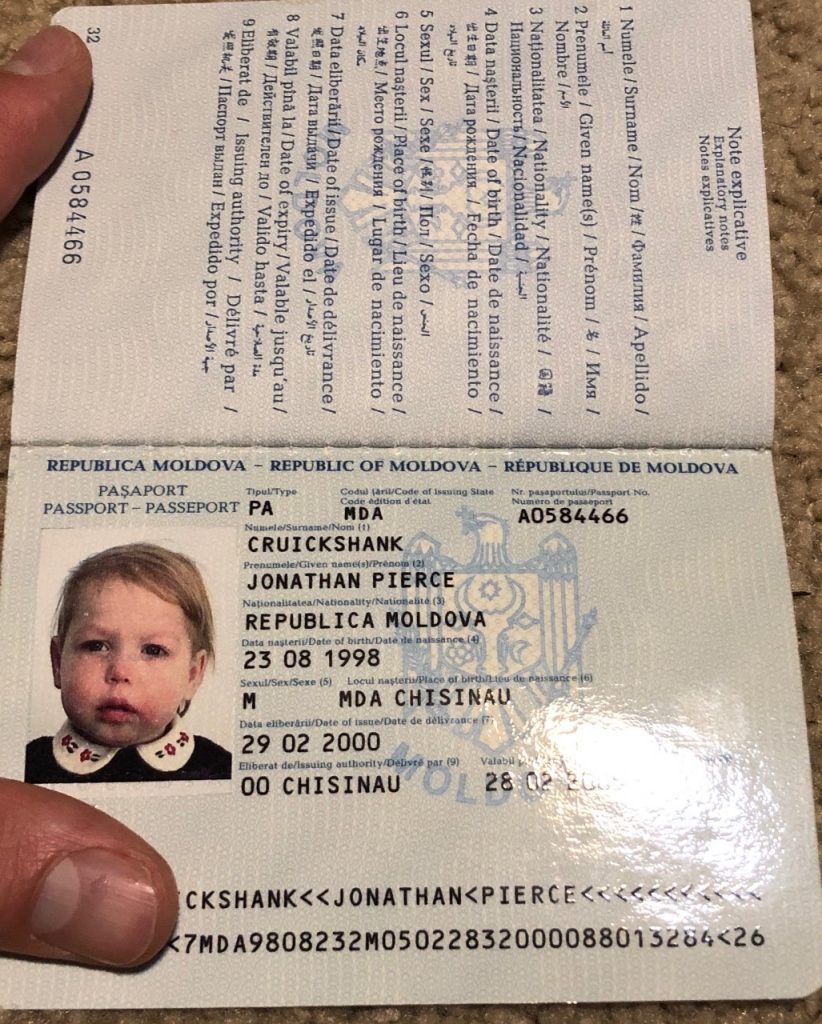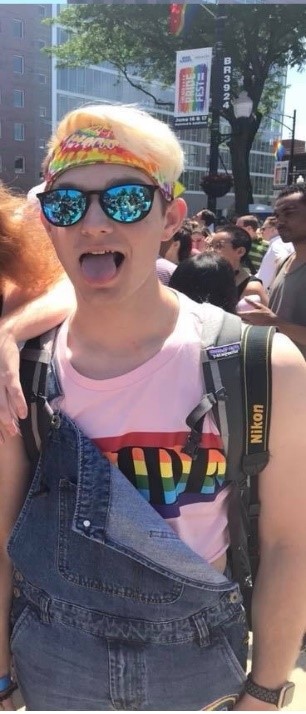
In recent years, there has been a growing acceptance for people who are LGBTQ+. We can see this through events like the United States making gay marriage legal in all 50 states, through shows like Queer Eye that have exploded in popularity and through many teenage movies such as Love, Simon that speak of acceptance. This outburst of support has been a recent development, and my friend Jonathan and I remember growing up in a time where it was still of taboo to be homosexual. Even more so when compared to 70 years ago. Gay people have been persecuted throughout history in almost every culture. They were included in the groups of people sent to death camps by the Nazis, but their stories are largely nonexistent. Discovering a chance to get the story of my gay best friend, seemed like a great way to honor the gay people who never got to tell their stories.
Jonathan was adopted from Moldova when he was a little over a year old. He grew up in, “…a very liberal, very comfortable family” (01:15). He admits to having a negative self-image while growing up, especially when he realized his sexuality and in turn how society viewed it at the time. He references one specific factor that played a role in this self-image, his father and the jokes made about gay people. I understood what he was talking about, growing up calling someone gay was just something you did, there was no thought behind it.


Similar to the mob mentality that people took on during the pogroms in WWII. “Before I even came out to anyone my dad would jokingly make like very crude jokes about gay people. And you know the funny thing is, there was no motive behind it” (02:25). The results were a complicated relationship between father and son, where Jonathan saw a complicated picture. On one hand, he saw his father as the liberal, very accepting man that was someone he could look up to, but on the other, he still said these horrible jokes about gay people, intentional or not. His father became an example of what Jonathan came to worry about other people. This same kind of fear many gay people back then had to live with as well, except none of them could come out. “If my own father thinks this, even if there is no motive behind it, then God what is someone walking down the street going to think of me?” (03:10).
When Jonathan finally did choose to come out to someone for the first time around 6th grade, it was not a well-received response, so much so that this person told him, “well that’s just disgusting” (05:28). This shocked me because Jonathan and I were friends for over a decade, yet I did not know about this incident. I was also shocked because of the response, it doesn’t make sense in my mind to justify saying something like to anyone regardless of your relationship. Jonathan responded to my disbelief, “So even if it wasn’t her like calling me disgusting, it was like her calling my sexuality disgusting [but that’s] still apart of me” (06:00). This was thankfully the only negative coming out experience that he ever had to deal with. Jonathan says that as he got older, he became more sure of himself, and that the people he did choose to come out to, it took a lot of confidence to do that. But it brings up that question anyway of why do gay people even need to “come out”? No one goes to their loved ones to declare being straight. Because in our society we just assume the default sexuality is heterosexual, and that because you’re not a part of the “norm” you need to officially declare it, which seems like it would have some negative stigma to it.

In addition to a bad first time coming out experience, Jonathan had experienced another negative response to him just being himself again, through words. We were seniors in high school at the time and he was working at a kid’s clothing store, primarily a girls one. He had been experiencing a normal shift when a father and daughter duo came into the store. He had assisted them in finding her some outfits, most of which she liked and they were ready to check out. As Jonathan was ringing them up for the clothes the father said something to Jonathan. “…the dad you know jokingly says “God you must be a fag to work here”. And I was just kind of like no, not really. Sexuality doesn’t really play a role in the hiring process here” (10:10). Jonathan said that nothing had escalated further from the one comment and that even though it may seem like a minor incident it was a major one in his life. I made the comment of comparing this remark to the ones that his father had made about gay people. They are the kind of comments that stem from ignorance and more people aren’t even aware of the implications that their words have. A big difference between the two is that Jonathan’s father genuinely cares about him and that this was a stranger trying to be funny. This was another incident that affected his self-image that he admits he is still struggling with today, but fortunately not enough to completely shatter the confidence that he has been building over the years.
The topic of self-image and worrying about what other people think led us into the discussion of things like public displays of affection (PDA) with a significant other. PDA is a common sight with straight couples, it is one of those things you grow up seeing on TV and in public spaces. Seeing PDA with a gay couple? Not nearly as common, although this trend seems to be changing. Jonathan however still feels that discomfort that society exudes when a gay couple chooses to display affection. “It’s not like I’m not comfortable with PDA and it’s not that I’m not comfortable holding my boyfriend’s hand while I walk down the street. It’s the fact that I don’t feel safe” (14:54). This is another one of those things that straight couples and people, in general, do not seem to worry about or have ever had to think about. As his friend I understood Jonathan put a lot of thought into his appearance and I always attributed that to someone who cared about their health and taking care of themselves. While maybe a small percentage of it may be that, most of his need to take care of self-image stems from the fear of being judged, and possibly a confrontation. In regards to someone actually approaching him and saying something just because of the way that he is, he says, “That’s more fearful to me because I know words have more of an impact that someone else’s actions do. It almost strikes me with fear and almost shuts me down to the point where, like I said, I’m not going to walk down the street. At least in Kansas City, I’m not going to walk down the street holding my boyfriend’s hand because I would feel very uncomfortable” (17:52). I understood why he would feel that way about Kansas City. Despite the progress that has been made in Kansas City for the LGBTQ+ community, it is still not nearly as accepting as a place like San Francisco. The representation in a state like Missouri is still so much more conservative than a place like California, and not having representatives who advocate for your sexuality still allows for those unfavorable parties to speak out against the gay community.

However, despite all of the negative experiences that Jonathan has dealt with, he is optimistic about the future. He believes that as our generation gets older, as well as all the younger ones, that a more accepting society will emerge. When I asked him there was one thing about our current society that he wished to change “that societal ideal that a man and a woman, that’s the perfect marriage” (19:04). He also offers one piece of advice to others that may be in a similar situation “Gauge your situation, and if you don’t feel comfortable doing it, then don’t do it” (20:43). He continued to talk about what made him so optimistic and this made me reflective. I had never discussed this with Jonathan so deeply before. And while I already viewed myself as someone who was accepting of gay people and people of different sexualities, I was never given the perspective of what it felt like to be gay. And with one of his final statements, he summed up how we both felt “People should and can be more tolerant” (22:56).

In Nancy Ziegler’s Self-Image and Sexuality, we get to learn about the struggles that a very young man faces due to his sexuality. In the past years, the LGBTQ community has begun to grow and society is slowly becoming more accepting of them. Through many historical events both in the past and in the present, the LGBTQ community was silenced in a way that they were not given the proper rights they deserve simply for being gay. After coming out as gay, Jonathan, Ziegler’s interviewee, didn’t receive the warmest welcome, his sexuality was called disgusting by a girl he trusted. After this experience, he gained more confidence to let the people he trusts the most know that he is gay. Sexuality was not accepted as much as it is today, back in the 1940’s. Ernst Rohm is an example of this, he was a gay Nazi leader but because being gay was unacceptable during this time, he was murdered. During the Holocaust, gay men would be sent to death camps simply because they were gay. In Ziegler’s interview, Jonathan, states “It’s the fact that I don’t feel safe” (14:54). Much like in the past, sexuality places people from the LGBTQ community in an uncomfortable situation where they feel like they are in danger.